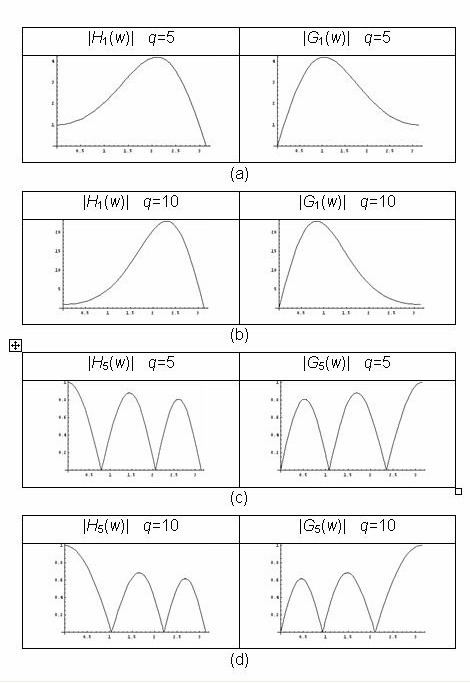 | ||
The Mathieu equation is a linear second-order differential equation with periodic coefficients. The French mathematician, E. Léonard Mathieu, first introduced this family of differential equations, nowadays termed Mathieu equations, in his “Memoir on vibrations of an elliptic membrane” in 1868. "Mathieu functions are applicable to a wide variety of physical phenomena, e.g., diffraction, amplitude distortion, inverted pendulum, stability of a floating body, radio frequency quadrupole, and vibration in a medium with modulated density"
Contents
Elliptic-cylinder wavelets
This is a wide family of wavelet system that provides a multiresolution analysis. The magnitude of the detail and smoothing filters corresponds to first-kind Mathieu functions with odd characteristic exponent. The number of notches of these filters can be easily designed by choosing the characteristic exponent. Elliptic-cylinder wavelets derived by this method possess potential application in the fields of optics and electromagnetism due to its symmetry.
Mathieu differential equations
Mathieu's equation is related to the wave equation for the elliptic cylinder. In 1868, the French mathematician Émile Léonard Mathieu introduced a family of differential equations nowadays termed Mathieu equations.
Given
The Mathieu equation is a linear second-order differential equation with periodic coefficients. For q = 0, it reduces to the well-known harmonic oscillator, a being the square of the frequency.
The solution of the Mathieu equation is the elliptic-cylinder harmonic, known as Mathieu functions. They have long been applied on a broad scope of wave-guide problems involving elliptical geometry, including:
- analysis for weak guiding for step index elliptical core optical fibres
- power transport of elliptical wave guides
- evaluating radiated waves of elliptical horn antennas
- elliptical annular microstrip antennas with arbitrary eccentricity
ν ) - scattering by a coated strip.
Mathieu functions: cosine-elliptic and sine-elliptic functions
In general, the solutions of Mathieu equation are not periodic. However, for a given q, periodic solutions exist for infinitely many special values (eigenvalues) of a. For several physically relevant solutions y must be periodic of period
One of four simpler types can be considered: Periodic solution (
For
ce and se are abbreviations for cosine-elliptic and sine-elliptic, respectively.
where the sums are taken over even (respectively odd) values of m if the period of y is
Given r, we denote henceforth
Interesting relationships are found when
Figure 1 shows two illustrative waveform of elliptic cosines, whose shape strongly depends on the parameters
Multiresolution analysis filters and Mathieu's equation
Wavelets are denoted by
The equation
The transfer function of the "detail filter" of a Mathieu wavelet is
The transfer function of the "smoothing filter" of a Mathieu wavelet is
The characteristic exponent
The magnitude of the transfer function corresponds exactly to the modulus of an elliptic-sine:
Examples of filter transfer function for a Mathieu MRA are shown in the figure 2. The value of a is adjusted to an eigenvalue in each case, leading to a periodic solution. Such solutions present a number of
The G and H filter coefficients of Mathieu MRA can be expressed in terms of the values
There exist recurrence relations among the coefficients:
for
It is straightforward to show that
Normalising conditions are
Waveform of Mathieu wavelets
Mathieu wavelets can be derived from the lowpass reconstruction filter by the cascade algorithm. Infinite Impulse Response filters (IIR filter) should be use since Mathieu wavelet has no compact support. Figure 3 shows emerging pattern that progressively looks like the wavelet's shape. Depending on the parameters a and q some waveforms (e.g. fig. 3b) can present a somewhat unusual shape.
